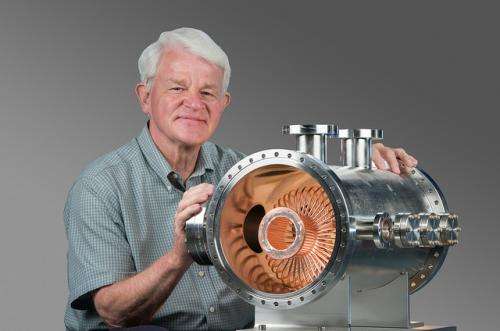Good news for small hospitals: Scientists develop affordable way to generate medical isotopes

Scientists at the U.S. Department of Energy's (DOE) Argonne National Laboratory have developed a safe and affordable way to ensure a reliable U.S. supply of certain medical isotopes. Although the invention is at a conceptual stage, it has the potential to provide critical medical diagnostic material for small regional hospitals.
This innovative technology combines two Argonne patents: a superconducting cage-like radio-frequency (RF) cavity and a dual electron linear accelerator in an energy-recovery configuration, said accelerator scientist John Noonan, one of the project's principle investigators. The technology is estimated to cost between $500,000 and $2 million to build. Even at the high end of that price range, the technology pairing would be affordable for even small hospitals to purchase and operate, he said.
In comparison, a conventional superconducting electron linear accelerator has been proposed as a high-yield medical isotope source. The estimated cost is $150 million.
The technology's affordability could help meet the growing demand for an already at-risk supply of technetium-99m (Tc-99m), Noonan said. The global supply of Tc-99m has been limited in recent years due to operational problems at the four aging nuclear reactors that produce 90 percent of the world's Tc-99m.
Tc-99m is a vital diagnostic tool for nuclear medicine. When injected into the human body, technetium-99m can detect cancers and diseases of the heart, bone and kidney.
The electron linear accelerator would also eliminate the need for nuclear safeguards since the accelerator can use the stable isotope molybdenum-100 instead of uranium to produce Tc-99m.
Electron linear accelerators are not limited to producing Tc-99m. There are a number of medical isotopes that can be generated using high energy electrons.
"Once commercialized, this accelerator technology has the potential to revitalize domestic production of technetium-99m, potentially create thousands of new jobs and save more lives by having this isotope readily available," said Paul Betten, a program manager in Argonne's Technology Development and Commercialization division.
Beyond the RF cage cavity's use in the production of medical isotopes, Betten believes that DOE could be a major user of this technology by permitting larger accelerators to be built at a lower cost, but also make smaller accelerators available for research at universities. DOE is the largest supporter of accelerator research and development in the United States.
More information: More information on medical isotopes: www.snm.org/
Provided by Argonne National Laboratory














